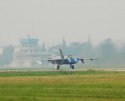You are using an out of date browser. It may not display this or other websites correctly.
You should upgrade or use an alternative browser.
You should upgrade or use an alternative browser.
J-20... The New Generation Fighter II
- Thread starter Asymptote
- Start date
- Status
- Not open for further replies.
Engineer
Major
For aircraft of the same shape but different size the larger aircraft has a larger moment of mass and so it is slower in following the control surface deflections. It is less easy to turn your nose.
Larger aircraft does not necessary mean larger moment of inertia, since inertia depends on distribution of mass and not just mass alone.
Engineer
Major
Thus it would make sense for the J20 to have above average internal fuel and range, so itself does not suffer from the same limitation of needing tankers to reach enemy support assets that would typically be operating well behind the 'front lines', hence its great size. It also features a huge nose, which would allow it to carry a significantly bigger radar than its peers, which would also make sense as it will likely be operating outside of friendly AWACS and ground based radar coverage.
There are two ways to improve the performance of the radar. One is by increasing the capability of the electronics and software, the other is by increasing the effective aperture of the radar. I think we can all agree that China is still slightly behind the US in areas of electronics. So, to make up for this, the size of the radar has to be bigger, and has to be bigger still to allow the J-20 to see the F-22 before the F-22 can see the J-20. The giant radome would allow this to happen.
A better comparison would be another known Chinese fighter jet with the pilot wearing the same type of helmet and using the helmet as the basis for measurement.
Smaller size=greater margin of error.
Engineer
Major
2. it could be bomber/striker: go undetected - drop the load - off
No it couldn't. The J in J-20 tells you this already.
Quickie
Colonel
Smaller size=greater margin of error.
A couple of close up pictures of a pilot in the J-20 cockpit is the thing to look for.
Picture of the J-20 with blue flames emitting from the nozzles:
...
Another picture of J-20's back:
...
Nice ... but I thought all flights so far were done without reheat ... so was there another flight ??
And the can we make any conclusions based on the exhaust color, about the engine-type ? As far as I know the AL-31F is known for its blueish AB, but I don't remember a TH-AB-photo.
Deino
Can anyone experiences with engines tell us anything given the color of the afterburner exhaust? It has a strong bluish hue of which I have never seen before.
J-10 has the same exhaust color. This seems to indicate that, unfortunately, Russian engines were used.
- Status
- Not open for further replies.


